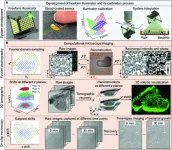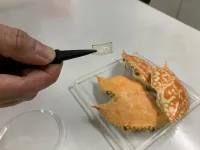A new study suggests that a common genetic signature may increase a person’s risk of developing substance use disorders, regardless of whether the addiction is to alcohol, tobacco, cannabis or opioids. The research, led by Washington University School of Medicine in St. Louis, eventually could lead to universal therapies to treat multiple substance use disorders and potentially help people diagnosed with more than one.
Published March 22 in the journal Nature Mental Health, the study’s findings are drawn from an analysis of genomic data from more than 1.1 million people of mostly European ancestry and a smaller population of people of African ancestry.
Substance use disorders have increased dramatically in recent years, with rising numbers of overdose deaths and increasing social, emotional and financial costs to families and communities. More than 46 million people over age 12 in the U.S. had at least one substance use disorder in 2021, according to the National Survey on Drug Use and Health. The most severe cases of substance use disorder typically involve use of more than one substance. However, most medications target the use of a specific substance, such as tobacco or opioids, rather than treating addiction broadly.
“There is a tremendous need for treatments that target addiction generally, given patterns of the use of multiple substances, lifetime substance use, and severity seen in the clinic,” said lead author Alexander Hatoum, PhD, a research assistant professor of psychological & brain sciences at Washington University. “Our study opens the door to identifying medications that may be leveraged to treat addiction broadly, which may be especially useful for treating more severe forms, including addiction to multiple substances.”
The study — led by Hatoum and co-senior authors Arpana Agrawal, PhD, a professor of psychiatry at Washington University School of Medicine; Ryan Bogdan, PhD, a professor of psychological & brain sciences at Washington University; Howard J. Edenberg, PhD, of Indiana University School of Medicine; and Joel Gelernter, MD, of the Yale School of Medicine — involved more than 150 researchers from institutions around the world. The research was supported by the National Institute on Drug Abuse, the National Institute on Alcohol Abuse and Alcoholism, the National Institute of Mental Health, the Eunice Kennedy Shriver National Institute of Child Health and Human Development, and the National Institute on Aging, all part of the National Institutes of Health (NIH).
“This study represents a major advance in understanding how genetic factors predispose people to substance use disorders,” Agrawal said. “While we have known for a while that many genetic factors are shared between different substance use disorders, our study identified some of the contributing genes, providing avenues for future biological and therapeutic discoveries for individuals with multiple addictions.”
The genetic signature associated with substance use disorders encompasses variations in multiple genes and is linked to regulation of dopamine signaling. Dopamine is a key signaling molecule in the brain’s reward system. Studies have shown that repeated exposures to addictive substances can cause the dopamine pathway in the brain to adapt to the effects of these substances, requiring more of the substance in order to receive the same amount of reward.
Previous research has implicated dopamine signaling in addiction, but most such studies have focused on a single substance. Further, the regulation of dopamine and neuronal development from the newly discovered genetic signature can help narrow down the specific forms of neuronal communication that are affected in substance use disorders.
“Anytime we look at addiction, we think dopamine is involved,” Hatoum said. “But here, we can implicate more specific mechanisms by which the brain regulates response to dopamine across different substances, and ultimately find processes that could reverse maladaptive regulation that leads to addiction.”
As part of the study, the researchers compiled a list of approved and investigational pharmaceutical drugs that have the potential to be repurposed to treat substance use disorders because the drugs may target the effects of the newly discovered genetic signature associated with addiction. The list includes more than 100 drugs to investigate in future clinical trials, including those that can influence regulation of dopamine signaling.
The risk of developing substance use disorders is influenced by the complex interplay of genetics and environment. The investigators looked for variations in the genome that were closely associated with such disorders in many individuals across large sample sizes, including 1,025,550 people of European ancestry and 92,630 people of African ancestry. This type of genome-wide association study can identify key genetic variations that are associated with increased risk of having one or multiple disorders.
Hatoum and his team found that the genetic variation underlying addiction includes 19 single letter differences in the DNA code that were significantly associated with general addiction risk, which could inform development of universal therapies for multiple addictions. It also includes 47 genetic variants linked to specific substance disorders — nine for alcohol, 32 for tobacco, five for cannabis and one for opioids. Such information could point to novel treatments for addiction to individual substances. However, it is likely that many more genetic differences are actually involved in shaping a person’s genetic liability to one or more addictions.
Separately, the genomic analysis of individuals of African ancestry showed only one genetic variation associated with general addiction risk and one substance-specific variation for risk of alcohol use disorder. The smaller sample size may be one reason for the more limited findings in this population. Hatoum emphasized the need for data collection on substance use disorders in even larger and more diverse ancestral populations to tease apart whether these associations are universal or vary across ancestries.
The genetic signature associated with increased risk of multiple substance use disorders also was linked to an increased likelihood of developing other health problems, including bipolar disorder, suicidal behavior, respiratory disease, heart disease and chronic pain. To serve as a control group for exposure to addictive substances, genetic data from over 4,500 9- and 10-year-old children of European ancestry who are participating in the national Adolescent Brain Cognitive Development Study — who presumably have not yet used addictive substances — were analyzed. The researchers found that children with the genetic signature for addiction were more likely to be related to someone who has a substance use disorder. The children also were more likely to show impulsive personality traits and disrupted sleep patterns, highlighting the possible role of these genes in early life behaviors, even before substance use occurs.
“This study could ultimately shift our conceptualization of addictive disorders, allowing novel pathways to research that will uncover more effective therapies for addiction,” Hatoum said.
###
This work was supported by the National Institutes of Health (NIH), under grant numbers K01 AA030083, T32 DA007261, DA54869, R01 DA54750, K02 DA32573, R21 AA027827, U01 DA055367, K01 DA51759, K23 MH121792, DP1 DA54394, T32 MH014276, R01 AA027522, F31 AA029934, R01 MH120219, RF1 AG073593, P30 AG066614, P2CHD042849, R33 DA047527 and T32 AA028259. The content presented in this release is solely the responsibility of the authors and does not necessarily represent the official views of the National Institutes of Health.
Hatoum AS, Colbert SMC, Johnson EC, Huggett SB, Deak JD, Pathak G, Jennings MV, Paul SE, Karcher NR, Hansen I, Baranger DAA, Edwards A, Grotzinger A, Substance Use Disorder Working Group of the Psychiatric Genomics Consortium, Tucker-Drob EM, Kranzler HR, Davis LK, Sanchez-Roige S, Polimanti R, Gelernter J, Edenberg HJ, Bogdan R, Agrawal A. Multivariate genome-wide association meta-analysis of over 1 million subjects identifies loci underlying multiple substance use disorders. Nature Mental Health. March 22, 2023.
About Washington University School of Medicine
WashU Medicine is a global leader in academic medicine, including biomedical research, patient care and educational programs with 2,800 faculty. Its National Institutes of Health (NIH) research funding portfolio is the third largest among U.S. medical schools, has grown 52% in the last six years, and, together with institutional investment, WashU Medicine commits well over $1 billion annually to basic and clinical research innovation and training. Its faculty practice is consistently within the top five in the country, with more than 1,800 faculty physicians practicing at 65 locations and who are also the medical staffs of Barnes-Jewish and St. Louis Children’s hospitals of BJC HealthCare. WashU Medicine has a storied history in MD/PhD training, recently dedicated $100 million to scholarships and curriculum renewal for its medical students, and is home to top-notch training programs in every medical subspecialty as well as physical therapy, occupational therapy, and audiology and communications sciences.
END






